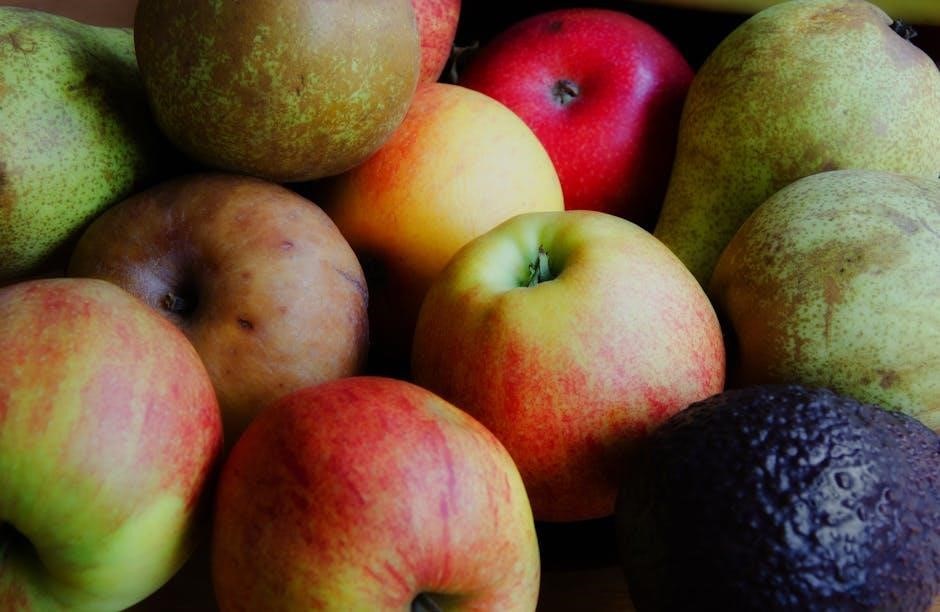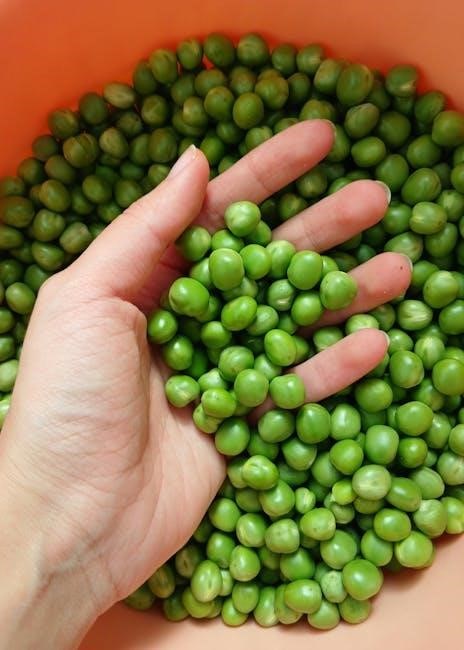Managing pancreatitis requires a tailored diet to reduce symptoms like nausea and abdominal pain. A low-fat, low-fiber diet helps minimize pancreatic strain, promoting recovery and overall health.
1.1 Understanding Pancreatitis and Its Impact on Digestion
Pancreatitis is an inflammation of the pancreas, disrupting its ability to produce digestive enzymes. This impairs digestion, leading to malabsorption of nutrients, diarrhea, and weight loss. The pancreas plays a crucial role in breaking down food into absorbable components, but inflammation hinders this process. Symptoms like abdominal pain, nausea, and vomiting further exacerbate digestive difficulties. Chronic pancreatitis often results in permanent damage, necessitating long-term dietary adjustments to manage symptoms and prevent complications. A tailored diet is essential to reduce pancreatic strain and support overall digestive health. Understanding this relationship is key to effective symptom management and improving quality of life.
1.2 The Role of Diet in Managing Pancreatitis Symptoms
Diet plays a crucial role in managing pancreatitis symptoms by reducing pancreatic workload. A low-fat, low-fiber diet minimizes digestive strain, helping to alleviate nausea, vomiting, and diarrhea. Clear fluids are often recommended initially to allow the pancreas to rest. Gradually introducing fat-free or low-fat foods helps prevent triggering symptoms. Avoiding high-fat and high-fiber foods reduces the risk of pancreatic irritation. A well-balanced diet ensures adequate nutrition while minimizing discomfort. By adhering to a tailored dietary plan, individuals can effectively manage symptoms, support recovery, and improve overall digestive health. This approach is essential for both acute and chronic pancreatitis management.
Types of Pancreatitis and Dietary Needs
Acute pancreatitis requires immediate dietary adjustments, starting with clear fluids. Chronic cases demand long-term low-fat, low-fiber diets to manage symptoms and prevent complications.
2.1 Acute Pancreatitis: Immediate Dietary Recommendations
Acute pancreatitis requires immediate dietary changes to allow the pancreas to heal. Patients often start with a clear fluid diet, such as broths and electrolyte-rich beverages, to minimize pancreatic stimulation. This phase is crucial for reducing inflammation and managing symptoms like nausea and abdominal pain. As symptoms improve, gradual introduction of low-fat, low-fiber foods is recommended. It is important to avoid high-fat or spicy foods during this phase, as they can trigger further inflammation. Consulting a healthcare provider ensures personalized dietary adjustments for optimal recovery. A structured approach helps prevent complications and supports the healing process effectively.
2.2 Chronic Pancreatitis: Long-Term Dietary Adjustments
Chronic pancreatitis requires long-term dietary adjustments to manage ongoing inflammation and prevent malnutrition. A low-fat diet, typically limiting fat intake to 30-50 grams per day, is often recommended to reduce pancreatic strain. Patients may need to avoid high-fat and high-fiber foods, which can exacerbate symptoms. Additionally, managing malabsorption issues through pancreatic enzyme replacement therapy (PERT) is crucial for proper nutrient absorption. Regular monitoring of symptoms and nutritional needs is essential to tailor the diet plan effectively. Over time, gradual reintroduction of select foods may be possible under medical guidance to ensure optimal health and symptom control.

Key Components of a Pancreatitis Diet
A pancreatitis diet focuses on low-fat, low-fiber foods to minimize pancreatic strain. Clear fluids, fat-free options, and nutrient-rich meals are essential to aid digestion and reduce symptoms effectively.
3.1 Low-Fat Diet: Reducing Fat Intake to 30-50 Grams per Day
A low-fat diet is crucial for managing pancreatitis, limiting daily fat intake to 30-50 grams. This reduces pancreatic strain, easing symptoms like pain and digestion issues. Fat-free and low-fat foods, such as lean proteins and non-dairy products, are recommended. Avoid high-fat items like fried foods and fatty meats. Portion control and food choices help maintain this restriction, ensuring nutrients are met without overburdening the pancreas. A structured meal plan, available in a printable PDF, guides patients in adhering to these dietary adjustments for effective symptom management and overall health improvement.
3.2 Low-Fiber Diet: Minimizing Digestive Strain
A low-fiber diet is essential for reducing digestive strain in pancreatitis patients. High-fiber foods, such as whole grains and seeds, can overstimulate the pancreas, worsening discomfort. By limiting fiber intake, the pancreas is given a chance to heal and function more efficiently. This approach helps manage symptoms like bloating, gas, and pain. A printable pancreatitis diet PDF provides detailed guidance on low-fiber food choices, ensuring patients can easily follow this dietary adjustment while maintaining nutritional balance and minimizing pancreatic irritation.
3.3 Clear Fluid Diet: The First Step in Recovery
A clear fluid diet is often the initial step in managing pancreatitis, helping to rest the pancreas and reduce inflammation. This phase includes broths, electrolyte-rich beverages, and clear juices, avoiding solids. A printable pancreatitis diet PDF offers structured guidance, ensuring patients can identify suitable fluids and progress safely. This approach helps stabilize digestion, prevent dehydration, and prepare the body for gradual reintroduction of solid foods, fostering a smooth recovery process while minimizing discomfort and complications.
3.4 Fat-Free and Low-Fat Food Options
Fat-free and low-fat foods are essential for managing pancreatitis, as they reduce pancreatic strain. Options include lean meats, non-fat dairy, and steamed vegetables. A printable pancreatitis diet PDF provides detailed lists of these foods, ensuring easy reference. Low-fat diets, often capped at 30-50 grams of fat daily, help avoid triggering symptoms. By focusing on nutrient-rich, low-fat choices, patients can maintain health while minimizing discomfort. This structured approach, outlined in downloadable guides, supports a balanced and therapeutic eating plan tailored to pancreatic health needs.
Progression of Diet in Pancreatitis Management
Diet progression for pancreatitis begins with clear fluids, then introduces low-fiber, low-fat foods, and gradually transitions to a regular diet as tolerance improves. A printable pancreatitis diet PDF guides this process.
4.1 Starting with Clear Fluids
Starting with clear fluids is the first step in managing pancreatitis, as it allows the pancreas to rest and recover. Clear fluids, such as broth, water, or electrolyte-rich beverages, are easy to digest and help replenish essential nutrients without putting strain on the pancreas. This phase is typically short-term and serves as an introduction to gentle nutrition. A printable pancreatitis diet PDF often includes a detailed list of approved clear fluids and guidelines for progression. This approach helps manage symptoms like nausea and vomiting while preparing the digestive system for more substantial foods.
After clear fluids, low-fiber, low-fat foods are gradually introduced to ease digestion without overloading the pancreas. Foods like lean proteins, steamed vegetables, and low-fat dairy are typically recommended. This phase helps rebuild digestive tolerance while minimizing symptom flare-ups. Portion sizes should be small and spaced throughout the day to avoid overwhelming the system. A printable pancreatitis diet PDF often provides specific food lists and portion guidelines for this stage. Monitoring how the body reacts is crucial, as individual tolerance can vary. This step-by-step approach ensures a smooth transition and supports long-term pancreatic health.
4.3 Transitioning to a Regular Diet
Transitioning to a regular diet occurs once the pancreas is stable and symptoms subside. This phase involves gradually introducing complex carbohydrates, lean proteins, and low-fat foods while avoiding high-fat or spicy items. Patients should monitor their tolerance and adjust portions accordingly. A printable pancreatitis diet PDF often includes guidelines for this transition, emphasizing the importance of avoiding triggers. Consulting a healthcare provider ensures a personalized approach, balancing nutritional needs with pancreatic health. This step is crucial for long-term management and preventing future episodes of pancreatitis.

Meal Planning for Pancreatitis
A structured 1,800-calorie meal plan helps manage symptoms, focusing on low-fat, low-fiber foods. A printable pancreatitis diet PDF provides organized daily nutrition guidance, ensuring balanced and safe eating.
5.1 Sample 7-Day Meal Plan (1,800 Calories)
This meal plan provides balanced nutrition for pancreatitis management, with daily calories restricted to 1,800. It includes low-fat, low-fiber options such as nonfat yogurt, lean proteins, and steamed vegetables. Breakfast options like oatmeal with banana and apple are gentle on the pancreas. Lunches feature grilled chicken or fish with quinoa and green beans. Dinners include turkey meatballs with low-fat pasta. Snacks like boiled apples and toast help maintain energy levels. The plan avoids high-fat and high-fiber foods to minimize discomfort and support recovery.
5.2 4-Week Mediterranean-Style Meal Plan
This 4-week Mediterranean-style meal plan extends the 7-day plan, offering a structured approach to managing pancreatitis. It includes breakfast, lunch, dinner, and snack options, all aligned with low-fat and low-fiber dietary needs. Recipes feature lean proteins like grilled chicken and fish, paired with steamed vegetables and whole grains. The plan emphasizes flavorful, nutritious meals while avoiding trigger foods. Digital access provides convenience, with shopping lists and prep guides to simplify meal preparation. This plan supports sustained digestion health and nutrient absorption, making it ideal for long-term pancreatitis management.
5.3 Breakfast, Lunch, and Dinner Recipes
This section offers a variety of easy-to-follow recipes designed for individuals managing pancreatitis. Breakfast options include low-fat oatmeal with berries and non-fat yogurt, while lunches feature lean proteins like grilled chicken with steamed vegetables. Dinners emphasize balanced meals such as baked fish with quinoa and green beans. Each recipe avoids high-fat and high-fiber ingredients, ensuring gentle digestion. Snacks like apple slices with almond butter are also included. These recipes are tailored to meet nutritional needs while minimizing pancreatic strain, providing a flavorful and healthy approach to mealtime. Download the printable PDF for convenient access to these recipes.
Foods to Avoid in Pancreatitis
Foods high in fat, fried items, and processed foods can trigger symptoms. Avoid spicy, high-fiber, and sugary foods that may irritate the pancreas and worsen inflammation.
6.1 High-Fat Foods That Trigger Symptoms
High-fat foods, such as fried foods, processed meats, and creamy sauces, can exacerbate pancreatitis symptoms. These foods stimulate the pancreas, increasing enzyme production and worsening inflammation. Fried foods, fast food, and high-fat dairy products are particularly problematic. Even healthy fats, like avocados and nuts, should be consumed in moderation if tolerance is low. Limiting fat intake to 30-50 grams per day is often recommended. Avoiding these triggers can help reduce pain and support recovery. Refer to the printable pancreatitis diet PDF for a detailed list of high-fat foods to avoid and healthier alternatives.
6.2 Foods That Can Irritate the Pancreas
Certain foods can irritate the pancreas, worsening inflammation and discomfort. Spicy foods, alcohol, and caffeine are common irritants that can trigger symptoms. Additionally, high-sugar and processed foods can contribute to pancreatic stress. Foods high in acidity, such as citrus fruits and tomatoes, may also exacerbate symptoms in some individuals. It’s crucial to identify and avoid these triggers to support healing. The printable pancreatitis diet PDF provides a comprehensive list of foods to avoid, helping you make informed dietary choices and manage symptoms effectively. Tailoring your diet to exclude these irritants can significantly improve comfort and recovery.
6.3 Avoiding Sugary and Processed Foods
Sugary and processed foods can negatively impact pancreatic health, increasing inflammation and discomfort. These foods often lack essential nutrients and can lead to blood sugar spikes, complicating conditions like diabetes, which is common in pancreatitis patients. Processed foods are typically high in unhealthy fats, sodium, and artificial additives. The printable pancreatitis diet PDF emphasizes avoiding these foods to promote healing and reduce symptoms. Instead, focus on whole, nutrient-rich foods to support overall health and manage pancreatic function effectively. This dietary approach helps minimize pancreatic strain and supports long-term recovery.

Pancreatic Enzyme Replacement Therapy (PERT)
Pancreatic Enzyme Replacement Therapy (PERT) is essential for managing pancreatic exocrine insufficiency, common in chronic pancreatitis. Enzymes aid digestion and nutrient absorption, supporting the dietary plan outlined in the printable pancreatitis diet PDF.
7.1 Understanding Pancreatic Exocrine Insufficiency (PEI)
Pancreatic Exocrine Insufficiency (PEI) occurs when the pancreas fails to produce enough digestive enzymes, impairing nutrient absorption. Common in chronic pancreatitis, it leads to malabsorption, diarrhea, and weight loss. A printable pancreatitis diet PDF can guide enzyme replacement therapy (PERT) and dietary adjustments to manage symptoms and restore nutritional balance. Early diagnosis and tailored interventions are crucial to prevent complications and improve quality of life for individuals with PEI.
7.2 Role of Enzyme Supplements in Digestion
Enzyme supplements play a crucial role in digestion for individuals with pancreatitis, particularly those with Pancreatic Exocrine Insufficiency (PEI). These supplements replace the enzymes the pancreas cannot produce, aiding in the breakdown of carbohydrates, proteins, and fats. By improving nutrient absorption, they help prevent malnutrition and alleviate symptoms like diarrhea and weight loss. A printable pancreatitis diet PDF often includes guidelines for enzyme therapy, ensuring proper dosing and timing with meals. This tailored approach supports overall digestive health and enhances quality of life for those managing pancreatitis.
Nutritional Deficiencies and Pancreatitis
Pancreatitis often leads to malabsorption of nutrients, causing deficiencies in fat-soluble vitamins and vitamin B12. This can result in complications like osteoporosis or anemia, requiring supplementation.
8.1 Malabsorption of Nutrients
Malabsorption of nutrients is common in pancreatitis due to reduced pancreatic enzyme production, leading to poor digestion of fats, proteins, and carbohydrates. This results in deficiencies of fat-soluble vitamins (A, D, E, K) and B12, as undigested nutrients pass into the stool. Chronic cases can cause diarrhea, weight loss, and malnutrition. A structured diet, as outlined in a printable pancreatitis diet PDF, helps manage these issues by emphasizing low-fat, easily digestible foods and necessary supplements, ensuring patients meet their nutritional needs while minimizing digestive strain.
8.2 Importance of Vitamin and Mineral Supplements
Vitamin and mineral supplements are crucial for managing nutrient deficiencies in pancreatitis, especially fat-soluble vitamins (A, D, E, K) and vitamin B12. Malabsorption due to pancreatic enzyme insufficiency often leads to these deficiencies. Supplements help compensate for poor digestion, ensuring proper nutrient levels. Fat-soluble vitamins require pancreatic enzymes for absorption, making supplementation essential. A printable pancreatitis diet PDF can guide patients on appropriate supplements and dosages. Regular blood tests and healthcare provider guidance are necessary to tailor supplementation plans effectively, ensuring optimal nutrient levels and overall health;

Lifestyle Factors in Managing Pancreatitis
Lifestyle factors play a key role in managing pancreatitis. Regular exercise, adequate sleep, and stress management are essential. Avoid smoking and limit alcohol to support recovery.
9.1 Exercise and Physical Activity
Regular exercise is crucial for managing pancreatitis, as it improves digestion and reduces inflammation. Gentle activities like walking, yoga, or swimming are recommended. Exercise helps maintain a healthy weight, enhances nutrient absorption, and boosts overall well-being. However, it’s important to avoid overexertion, especially during flare-ups. Patients should consult their healthcare provider to create a safe exercise plan tailored to their condition. Incorporating physical activity into daily routines can significantly support recovery and long-term health management in pancreatitis.
9.2 Importance of Sleep and Stress Management
Quality sleep and stress management are essential for managing pancreatitis. Lack of sleep can exacerbate symptoms, while chronic stress may trigger inflammation. Practicing relaxation techniques like deep breathing, meditation, or yoga can help reduce stress levels. Aim for 7-8 hours of sleep daily to support healing and digestion. Establishing a consistent sleep routine and creating a calming environment can improve rest quality. Combining these practices with a balanced diet enhances overall well-being and supports pancreatitis management effectively.

Monitoring and Adjusting the Diet Plan
Regularly track symptoms, food intake, and nutritional needs to tailor your diet plan effectively. Adjustments ensure proper nutrition and prevent malnutrition while managing pancreatitis symptoms.
10.1 Tracking Symptoms and Nutritional Needs
Monitoring symptoms like nausea, pain, and diarrhea helps identify dietary triggers. Keeping a food diary can track nutrient intake and ensure adequate protein, vitamins, and minerals. Regular assessments prevent deficiencies and guide adjustments for better symptom control.
10.2 Regular Consultations with a Healthcare Provider
Regular check-ups with a healthcare provider ensure your diet plan is effective and tailored to your condition. They review symptom progress, adjust nutritional advice, and monitor for complications, ensuring optimal health outcomes.
Printable Resources for Pancreatitis Diet
Downloadable resources like the printable pancreatitis diet PDF and 7-day meal plan provide structured guidance, helping you manage symptoms effectively with clear food lists and recipes.
11.1 Printable Pancreatitis Diet PDF
A printable pancreatitis diet PDF offers a comprehensive guide to managing symptoms through nutrition. It includes a structured 7-day meal plan, food lists, and recipes tailored to reduce pancreatic strain. The PDF provides clear guidelines on low-fat, low-fiber diets and highlights foods to avoid. With detailed shopping tips and nutritional advice, it helps users adhere to dietary recommendations. This resource is designed to simplify meal planning, ensuring adherence to medical guidelines while meeting nutritional needs. Download and print the PDF for easy reference, making it a practical tool for daily meal preparation and symptom management;
11.2 Downloadable 7-Day Meal Plan PDF
The downloadable 7-day meal plan PDF provides a structured approach to managing pancreatitis symptoms. It includes detailed breakfast, lunch, and dinner options, ensuring a balanced intake of nutrients while avoiding trigger foods. The plan is designed to be easy to follow, with clear portion sizes and cooking instructions. It incorporates low-fat, low-fiber recipes tailored to reduce pancreatic strain. This resource is ideal for individuals seeking a practical guide to meal planning, helping them maintain nutritional balance and alleviate symptoms effectively. The PDF is adaptable, making it a valuable tool for ongoing dietary management.
11.3 Pancreatitis Food List and Shopping Guide
The pancreatitis food list and shopping guide provides a comprehensive overview of safe foods to eat while managing the condition. It focuses on low-fat, low-fiber options, emphasizing non-fat dairy, lean proteins, and easily digestible vegetables. The guide also highlights foods to avoid, such as high-fat and sugary items, to prevent symptom flare-ups. Practical shopping tips are included to make grocery planning easier. This resource ensures individuals can maintain a balanced diet while adhering to dietary restrictions, helping to manage symptoms effectively and support overall health.
Adhering to a tailored diet is crucial for managing pancreatitis. Downloadable resources like the printable pancreatitis diet PDF provide essential guidance for symptom relief and long-term health management.
12.1 Summary of Key Dietary Recommendations
Managing pancreatitis effectively requires adherence to a tailored diet. Key recommendations include reducing fat intake to 30-50 grams daily, minimizing fiber, and starting with clear fluids. Progressing to low-fat, low-fiber foods and eventually a regular diet is essential. Avoiding high-fat, sugary, and processed foods helps prevent symptom flare-ups. Utilizing resources like a printable pancreatitis diet PDF ensures structured meal planning and guides food choices. Combining dietary changes with enzyme therapy and lifestyle adjustments supports long-term health and symptom relief. Consistency and consultation with healthcare providers are vital for personalized care and optimal outcomes.
12.2 Final Thoughts on Managing Pancreatitis Through Diet
Adopting a tailored diet is crucial for managing pancreatitis effectively. By focusing on low-fat, low-fiber foods and clear fluids, individuals can alleviate symptoms and support pancreatic health. Utilizing resources like a printable pancreatitis diet PDF provides structured guidance for meal planning and food selection. Consistency in following dietary recommendations, combined with enzyme therapy and lifestyle changes, is key to long-term well-being. Regular consultation with healthcare providers ensures personalized care and optimal symptom management, empowering individuals to navigate pancreatitis confidently and improve their quality of life.
